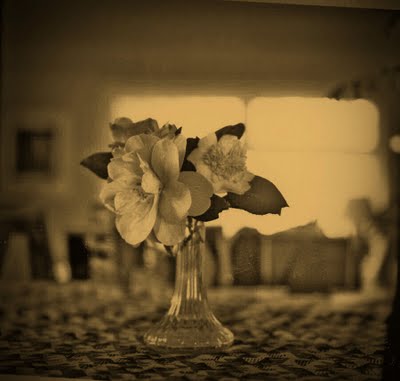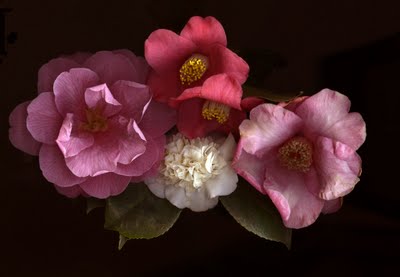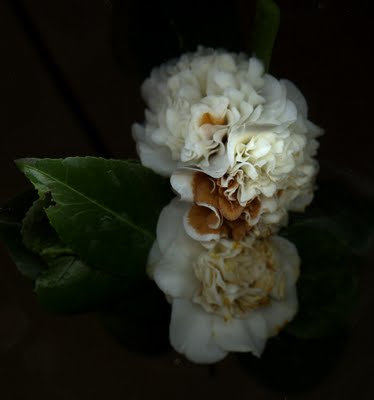S.O.S. Help!
Friday, March 26, 2010

Doug Jasinski and his other smart co-workers at the design firm Skunkworks designed (a web page that even if I am unable to be completely objective I must say is just right!)my web page in the waning days of 2005. It was up in January and by January 20 my web page had an attached (ancillary) blog. You can see what that first, and rather inauspicious looking posting looked like above!
I had no idea what a blog was or its purpose. My first reaction to Doug Jasinski was to enquire why my blog had no provision for comments. Within minutes the feature was installed and within hours I quickly found out why Jasinski had not given me that feature in the first place. There were all sorts of nasty comments which I could not handle emotionally nor did I have the time to remove. In short order I decided that besides not allowing comments I would refrain from rants were possible and I would never carry ads or do quid-pro-quo linking to other blogs or websites unless it was my personal choice. I never installed any device to tell me how many people click on my blog. When I press on the “Publish” spot in Blogger I have no idea of where my blog is going to.
The original purpose of this blog (and one that I now know with certainty) is to satisfy myself. Not only does it do that but it has stifled (eased) the frustration that I have suffered in the last few years in being unable (as magazines and papers have gone into decline and no longer maintain or have the willingness of having a healthy relationship with freelancers). My blog has become my de facto and personal magazine in which I “publish” the pictures I want and write what I want.
That my blog has also satisfied members of my family was unintended by I am happy for them. They were curious about my past and were reluctant to ask me about it. The blog has answered many of their questions.
This blog has made me realize the depth of my photographic archives and there is no doubt in my mind that I will be rich and famous (when I am dead).
The folks at Skunkworks gave me what I wanted and I am not sure they knew what I wanted nor did they know what they were giving me. What they gave me (perfection!) was a custom URL domain blog that is driven by FTP. At the time (2005) FTP was cutting edge but not anymore. This means (I am not all that sure so my explanation will be hazy) that my pictures (in my computer's hard drive) and the copy I write all get transferred to a server. The server in question is by the company that hosts my web page. They are called Net Nation. From Net Nation the pictures and copy then are transferred to Blogger. In Blogger I have learned to use what I thought were limited formatting tools so that I am able to place pictures here and there and have copy wrap around them very much like a magazine. My friend Tim Bray, the Guru of Sun Microsystems and now a resident Guru at Google Android suggested back in January 2006 that my blog have an RSS feed and an individual URL address for every blog posting of the day. Skunkworks installed them and the rest is my blog history.
If any of you readers out there would ask me, “Are you happy as you blog is right now?” I would assert that I am indeed happy and that I would not want to change any of it. Unfortunately I recently received this letter (but I must point out that the deadline mentioned was extended to May 1):
Dear FTP user:
You are receiving this e-mail because one or more of your blogs at Blogger.com are set up to publish via FTP. We recently announced a planned shut-down of FTP support on Blogger Buzz (the official Blogger blog), and wanted to make sure you saw the announcement. We will be following up with more information via e-mail in the weeks ahead, and regularly updating a blog dedicated to this service shut-down here: http://blogger-ftp.blogspot.com/.
The full text of the announcement at Blogger Buzz follows.
Last May, we discussed a number of challenges facing[1] Blogger users who relied on FTP to publish their blogs. FTP remains a significant drain on our ability to improve Blogger: only .5% of active blogs are published via FTP — yet the percentage of our engineering resources devoted to supporting FTP vastly exceeds that. On top of this, critical infrastructure that our FTP support relies on at Google will soon become unavailable, which would require that we completely rewrite the code that handles our FTP processing.
Three years ago we launched Custom Domains[2] to give users the simplicity of Blogger, the scalability of Google hosting, and the flexibility of hosting your blog at your own URL. Last year's post discussed the advantages of custom domains over FTP[3] and addressed a number of reasons users have continued to use FTP publishing. (If you're interested in reading more about Custom Domains, our Help Center has a good overview[4] of how to use them on your blog.) In evaluating the investment needed to continue supporting FTP, we have decided that we could not justify diverting further engineering resources away from building new features for all users.
For that reason, we are announcing today that we will no longer support FTP publishing in Blogger after March 26, 2010. We realize that this will not necessarily be welcome news for some users, and we are committed to making the transition as seamless as possible. To that end:
o We are building a migration tool that will walk users through a migration from their current URL to a Blogger-managed URL (either a Custom Domain or a Blogspot URL) that will be available to all users the week of February 22. This tool will handle redirecting traffic from the old URL to the new URL, and will handle the vast majority of situations.
o We will be providing a dedicated blog[5] and help documentation
o Blogger team members will also be available to answer questions on the forum, comments on the blog, and in a few scheduled conference calls once the tool is released .
We have a number of big releases planned in 2010. While we recognize that this decision will frustrate some users, we look forward to showing you the many great things on the way. Thanks for using Blogger.
Regards,
Rick Klau
Blogger Product Manager
1600 Amphitheatre Parkway
Mountain View, CA 94043
[1] http://buzz.blogger.com/2009/05/ftp-vs-custom-domains.html
[2] http://buzz.blogger.com/2007/01/blogger-custom-domains.html
[3] http://buzz.blogger.com/2009/05/ftp-vs-custom-domains.html
[4] http://www.google.com/support/blogger/bin/answer.py?hl=en&answer=55373
[5] http://blogger-ftp.blogspot.com/
----
This e-mail is being sent to notify you of important changes to your Blogger account.
I have a May 1 deadline to migrate my blog to a Blogger supported custom domain but I have no idea what my blog will look like. Blogger asserts that my blog (FTP driven) represents less than 5% of the blogs they maintain. I have no idea if my blog address will change. I have no idea of what would happen should the migration abort. I suspect that the folks at Net Nation would have the blog all backed up. I don’t even know that. I have been unable to get an answer from the several computer gurus I know. The answers to my questions are not there because my questions are much too specialized even if the questioner knows absolutely nothing about it!
I make an appeal to any reader out there with a similar problem who just might have some answers. Blogger which is committed to supporting this blog until May 1 has been disrupting it for the last three weeks as I am unable to publish pictures or copy without repeated efforts that in some cases take hours.
And I almost don't have to point out that my return email to Mr. Rick Klau never received an answer. For anybody who might want to help I can be reached by the Contact Submission section of my web page.
This blog is now located at http://blog.alexwaterhousehayward.com/.
You will be automatically redirected in 30 seconds, or you may click here.
For feed subscribers, please update your feed subscriptions to
http://blog.alexwaterhousehayward.com/feeds/posts/default.
Fetish For Fishnets
Thursday, March 25, 2010
Well my sweet baby wears fishnet stockings
When she starts a rockin' there ain't no stoppin'

Singing wop bop a doo dop fishnet stockings
Shoo wop a doo dop when she's rockin'
Bop bop a doo dop there ain't no stoppin'
Rockin' with my baby in her fishnet stockings

Well she's got a pair in pink
She's got a pair in red
When she puts the black ones she makes me loose my head
The Stray Cats

As far as I know I am not a sexual deviate. I dislike fetish and fetish photography. I don't understand the pleasure of tying up people or being tied up. My tastes are pretty simple. But I do like fishnets. In fact I would venture to admit that I have a fetish for fishnets and particulary if the fishnets happen to be torn. I connect fishnets with sleezy, dark and mysterious. Which is why I have a particular liking for the pictures you see here of Roksana, the Polish-born banker who lives in London. She dresses and looks like a sophisticated James Bond woman. She has money. She seems well-bahaved. It is because of it all that Roksana shines in fishnets. If I had had the time for more photographs I would have photographed her in a private school uniform. That's another fetish of mine, in case you didn't know.

A few years ago I was driving North on Granville and I crossed King Edward Avenue. That is where York House School is. As I was passing the bus stop on the Northwest side of Granville my right eye caught two York House students in a passionate embrace. They were kissing. I almost lost control of the car I was so shocked and affected by the sight.

The particular look of the first 6 pictures here is the result of using the now sadly discontinued Kodak b+w Infrared Film. One had to shoot through a deep red filter (a No. 25) and once one focused one had to unfocus to the infrared mark on the lens. Infrared film's spectrum focuses at a different distance. Most photographers who ever used the film tended to print their pictures light. Mine here (or at least on my monitor) are darkish which is the way I like them. I have a few rolls of Kodak Infrared film in my freezer and I am looking for the appearance of someone like my Polish banker to pose, perhaps in fishnets.



Joji's Is Still There
Wednesday, March 24, 2010

You can sit and look at art in a gallery. At Joji’s you can have your hair done too. Borrowing the idea from the yearly Artworks On The Drive, when stores on Commercial Drive display art on the street, Joji has a monthly art show in her salon. She has featured Jan Crawford, Dana Irving, Katarina Thorsen and the photographs of Natasha Moric.
Joji, from Hull Quebec, has been on the drive for five years and says, “I have brought a downtown salon to the Eastside. Many of our clients are artists who are demanding. We are up there with Suki’s as one of the ten best in town. We believe in doting over and papering our clients to the hilt. You can sip coffee from Casa del Café while you get your Japanese shampoo.” If it weren’t enough you can always walk down a block to Joe’s Café, buy that special Mexican Chicken at the Nazarene Market, up a block, or stock up with groceries and vegetables at the Santa Barbara Market next door.
If you don’t spot Joji in her gaucho hat at your next appointment, don’t be surprised. She is probably perfecting her style at the London Academy or the School of Vidal Sassoon.

If you wonder about the above piece an example of “service oriented editorial drivel” I can only cite my ignorance on the matter. I wrote it for Western Living sometime in the late 80s and I am not sure they ever ran it accompanied by my photograph of the beautiful Maurice and the Clichés groupie and model, D’Arcy.
Of the places mentioned Joji’s remains as does the Santa Barbara Market and Joe's Cafe.
In the heady days of magazines in Vancouver, the 80s!, we freelancers just didn’t wait for the phone to ring with the next assignment. We indulged in the daring sport called speculative work. In my case I photographed D’Arcy (film cost money) and interviewed Joji and then wrote the piece. The idea was that magazine editors were a tad lazy and they liked being offered a package. For me, this was not usually the case. It was easier for a writer to convince an editor on a speculative piece than for a photographer to do so with an editor. It was after a few of these failures that I began to concentrate on writing pieces without offering pictures to accompany them. My success rate improved and in most cases I was assigned to take the pictures
Damion Invites Me To Tea
Tuesday, March 23, 2010

The first Chinese person I have memory of was a girl in my class at the American Grammar School in Buenos Aires. We were both in the fourth grade and she was the top math student and tops in just about anything else. Since she was the only Chinese person I had ever seen she was as exotic as any person could possibly be. She must have had an older sister or brother that my mother taught at the American High School as we were invited for dinner one weekend. The family must have been part of the diplomatic corps. I don’t remember much except that we sat at a table that had bowls and those wonderful “modern art” swoops that a Chinese spoon has always been for me. I was not an adventurous eater but I managed to stuff it all in without asking what it was.
When we arrived in Vancouver in 1975 I got my first real taste of cultural diversity. I marveled at the men in turbans and the bustle of China Town.
In the late 70s I began to frequent the Drake Hotel. I had become a fan of ecdysiasts. The profession had little ethnic variety. It did not go any further than, as an example, English Ana (as we called her) or “Emma Peel” which was her stage name. The one truly exotic exotic was Damion. She was a Canadian Chinese. Why she had chosen the profession I never did ask.
Romans and Greeks were noted for their noble noses and we can single out beautiful legs, large eyes and flowing hair in persons. But when it comes to singling out such bits as breasts, even when they are beautiful we must keep our mouth shut or be labeled sexist.
Damion had beautiful breasts and a flowing dance style. She used her long black hair for strategic cover during part of her performance.
I photographed Damion in her living room sometime in the 80s. Her house was on Marine Drive by the Knight Street Bridge. Somehow the noise of the trucks outside was ameliorated by the cozy situation of her living room. I took 20 pictures of her. I studied every one of them under a loupe today before I scanned one. To my dismay I had not taken one single one in which her nipple was not showing! But thanks to the “censorship tool” of Photoshop, Damion, once again, strategically covered that which must not be shown here.
The next day after our portrait session, Damion woke up with chest pains. She was rushed to the hospital and was, right then and there, subjected to open heart surgery to save her life. I never saw her again.
Camellias, Tea, Soot & Menstrual Cycles
Monday, March 22, 2010

In our bedroom we have a large antique lawyer’s bookcase full of botanical books we began to purchase in 1986 when we moved to our current corner lot on Athlone Street. In it I have all my American Hosta Society Journals since I became a member in 1992. When Rosemary became interested in clematis or hardy geraniums or I suddenly could not read enough about roses, ferns, hydrangeas or euphorbias we bought the corresponding books on them.
Of all the books in the bookcase the only one I consult with regularity is Peter Beales’ Classic Roses. I also know that in the dead of winter I can discern hope in the spring by reading Christopher Lloyd’s pithy books on gardening. His books are opinionated but accurate almost as if they were written by a botanically enclined John McPhee.
For the last few weeks the four camellias in our garden have been showing off. I have been thinking how I could scan the flowers and write about them for the blog. The idea came yesterday when I received a phone call from my friend Mark Budgen who wanted to compare notes on our mutual like for very good loose tea.
Anybody who has gone beyond the usual “flow-thru” and un-ritualistic cup of contemporary brew that passes for tea must know that all tea (as in black and green) comes from one plant and that the plant in question is the lowly Camellia sinensis (its flowers do not compare to those of its flashier cousins) Camellia japonica and other species camellias and cultivars.
When the Brits showed interest in the liquid in the beginning of the 19th Century the crafty Chinese shipped plants of Camellia japonica. In spite of its beautiful flowers the leaves will not brew any tea of consequence.
The story of tea is told best by a woman called Frances Perry who wrote many books on plants. We have one of them called Flowers of the World – Illustrated by Leslie Greenwood – Foreword by The Lord Aberconway and published in collaboration with the Royal Horticultural Society, 1972. This with Peter Beales’ Classic Roses would be my desert island botanical tomes of choice.
Here is what Perry says (verbatim) of the camellia in its connection to tea (and along the way I find about the correct pronunciation of the word!).
The genus is named for Georg Kamel (Latinized as Camellus a Jesuit priest (1661-1706) who was particularly interested in natural science. He collected plants in both the Philippines and China although opinions differ as to whether he brought back Camellia seeds to Europe. Certainly he was responsible for introducing the St Ignatius Bean to Europe (Strychnos ignatii), one source of strychnine, and he also wrote a history of the plants of Luzon.
Economically the most important species is Camellia sinensis, the Tea Plant, the national beverage of China and one much prized by the English. Many tales and legends surround this plant, an especially charming story referring to an Indian Prince and Buddhist monk called Bodhidharma. This Prince is supposed to have landed on the shores of China in A.D. 510 with the object of converting its natives to Buddhism. To that end he dedicated his life to sleeplessness but one day, after years of wakeful teaching, praying and meditation Ta-Mo (as he was known to the Chinese) fell asleep. Mortified by this weakness of the flesh he cut off his eyelids and threw them on the ground where Buddha caused them to sprout and take root. These became the first Tea plants, the dried leaves of which assume the shape of eyelids and are supposed to represent and induce wakefulness.
Their employment as a beverage is supposed to have been discovered by another Buddhist. He lived the frugal life of a hermit and one day while making a fire with branches of Tea plant he accidentally dropped some leaves in a pot of boiling water. Later he tasted the liquid and finding it exhilarating and pleasant to the palate imparted the discovery to others. And so in course of time the practice of tea-making spread.
Around 1606 the Dutch set up Tea plantations in Java and soon afterwards brought this new beverage to Europe. In 1650 Peter Stuyvesant took it to North America although curiously it was 1652 before Tea reached England…Camellias (pronounced mell not meel)…

I cite the above information simply because of my paradoxical situation of wanting to keep all my books and at the same time realizing I don’t need them anymore. If I want to find information on why soot seems to appear on the leaves of my camellias (a common malady of camellias in our climate) I will find all the relevant information on the net. Few of my books unless I look into a specialized camellia book (I don’t have one) will explain that the black soot is a fungus or ‘sooty mould’ growing on the sugary honeydew secreted by aphids or scale insects. The honey dew drips down from the insects to the upper surface of the leaf below where the mould then grows. Although not harmful to the plant itself, the mould is a certain indication of the presence of one or other of these pests. It is readily moved with a cloth and warm soapy water, but to prevent its reappearance the root cause of the problem must be tackled. Although there are many types of scale insect, the one most commonly found on camellias is Pulvinaria floccifera, known as Cushion Scale or Cottony Camellia Scale.
They appear as small (up to about 5mm long), oval shells, ranging in colour from yellowy-green to brown, and found anchored limpet-like to the underside of leaves and sometimes on the stems. In late spring/early summer the females lay their eggs, which appear as a characteristic trail of white fluff behind them. The adults then die, and may drop from the leaf, leaving only the eggs behind. These hatch a few weeks later, and the tiny crawlers’ disperse themselves over the plant, or are blown by the wind to neighbouring plants, before attaching themselves to a leaf and beginning feeding. It is at this stage of their life-cycle that the insects are most vulnerable, before their waxy shell is fully developed.
Aphids are to be found on the soft, new growth and, later in the season, on the developing flower buds. Like scale insects, aphids are usually found on the underside of leaves where, undisturbed, they can rapidly form large colonies. As the plant growth hardens they will move on, but not before having distorted the foliage and formed lots of honeydew. Prevention is better than cure, and small numbers are easily controlled by wiping off with a damp cloth, or spraying with a jet of water. In fact I spray my camellias with a solution of warm water and dish soap and then I hose them off. A lot, but not all of the soot disappears.
In other botanical journals I found out that the British (and the East India Company) were stymied in not being able to get tea plants from the Chinese. In the 1840s English botanical adventurer Robert Fortune snuck into China and dressed as a Chinese potentate spied around and learned that both green tea (unfermented leaf) and black tea (fermented leaf) came from the same Camellia sinensis. He bribed officials and spirited plants out of China to India. Most died but enough survived and the rest (and why we have Assam and Ceylon tea) is history.
The camellias in my garden consist of two we purchased, one that came with the garden and one (the white one) that I liberated years ago from a nearby home that was going to be demolished. In the picture on the left is Camellia x willimasii ‘Donation”. On the far right there is a spent flower of Camellia x williamsii “Aunt Mavis’ (the earliest to bloom camellia in my garden) selected and named by my friend Alleyne Cook. In the middle at the top is the original camellia of the garden some sort of camellia japonica. I do not know what the white one is. But it is the white camellia that finally answered my question of why Alexandre Dumas’ (fils) novel The Lady of the Camellias is called so.

In The Lady of the Camellias by Alexandre Dumas Fills translated by Sir Emdond Gosse and with an introduction by Toril Moi, Moi writes:
In chapter II we learn that Marguerite was called the Lady of the Camellias because she was always carrying a bouquet of camellias. “For twenty-five days of the month the camellias were white, and for five days they were red; no one ever knew the reason for the change of colour, which I mention though I cannot explain it,” the narrator (p. 15) disingenuously declares. The visible and public sign of Marguerite’s menstrual cycle, the camellias signify her sex and signal her sexual availability.

Camellias, moreover, are particularly fragile flowers; they quickly turn brown, and for a long time they were not terribly popular. One commentator claims that they were disliked because the flowers drop off intact “like the head of a man decapitated by a sword.” Thus the very name “the Lady of the Camellia reinforces the novel’s obsession with the connection between a woman’s sex and her death
Vancouver Urban Affairs - Air Rushing Into A Vacuum
Sunday, March 21, 2010
I am no longer accustomed to throwing in my two cents on civic issues, except around dinner tables and in canoes on distant lakes. But I am ready to join those who are concerned about the Vancouver Art Gallery's (VAG) decision to move to Larwill Park (aka, the old bus station site at Cambie and Dunsmuir).
Darlene Marzari, March 17, 2010

Darlene Marzari (seen here in picture, with from left to right, Mike Harcourt and Shirley Chan) has and intelligent take on the moving of the Vancouver Art Gallery in an op-ed essay Think City (a web magazine on Vancouver City urban affairs) here.
I sent the link to my friend Mark Budgen who replied with:
Interesting. Why is it that Think City, a coalition of so many esteemed organizations, has so little influence in what actually happens in Vancouver?
Budgen’s short statement left me bewildered and I spent most of Sunday thinking of an answer. Budgen and I talked on the phone and we echanged e-mails. In one he wrote:
I ask because they[Think City] seem to have some good ideas that are tweaks rather than fundamental thoughts as to the direction of the city for the next several decades. It wants a ward system but Sam Sullivan successfully saw that off a few years back. What about metropolitan government? Taking control of transit? More taxing powers for the city? A police force that crosses boundaries just as the crooks do?
I thought about it hard and suddenly I had a memory of walking on Beatty Street some years back and looking into the window of the restaurant that serves American Southern style barbecue. I spotted two men deep in conversation. One of them was Vancouver Sun columnist Vaugh Palmer and the other was then Editor-in-Chief John Cruickshank (below). Watching them I felt a sense of comfort. I knew that these two intelligent men were somehow discussing the state of our city and of our province. With them around I felt that things would happen for the better.

I don’t think that vision would ever repeat itself. That newspaper, like many others is in a rapid decline of importance in our city’s and province’s affairs. Cruickshank moved from Vancouver to the Chicago Sun Times, from there he went to the CBC and now he is the influential publisher of the Toronto Star. He is often heard in CBC panels on current affairs. I respect the man and I only wish he would return to our city. Of Vaughn Palmer I can only repeat what others have told me. And that is that as soon as he had his TV program his written views somehow became diluted.
There are other Vancouver Sun columnists I admire like Miro Cernetig, Ian Mulgrew and David Baines. John Mackie every once in a while writes excellent columns about the state of our city’s architecture. I would wish that garden columnist Steve Whysall would perhaps tackle city landscaping issues. Columnist Pete McMartin writes city oriented pieces every once in a while to make me think what the trio of Cernetig, Mulgrew and McMartin could do if they honed their direction into just civic affairs.
With the loss (thank God!) of our infamous stock exchange I find that David Baines’ watchdog columns on those dishonest traders would best be directed towards issues such as the one of city politicians dancing with developers. I am sure that Baines would discover stuff that would perhaps begin to help wane the outrageous influence that developers have in our city.
Many would say that the Vancouver Sun is a paper in decline and going towards a state of irrelevance. I would strongly disagree. Just the publishing of Abraham Rogatnick’s views against the moving of the Vancouver Art Gallery a couple of weeks ago on their editorial page generated many intelligent comments on subsequent days in the pages of the newspaper. I would suspect that the publishing of Rogatnick’s manifesto led Darlene Marzari to write her essay on the matter.
The Vancouver Sun still has influence but like papers in other cities and countries it has suffered the dilution of influence as people read stuff on the web.
Fifteen years ago Vancouver Magazine editor, Malcolm Parry would run a story, every couple of years, on the state of radio, TV and the city’s newspapers. These articles were articles that people read and talked about. These articles generated op-ed articles in the media. People were talking. Discussing which restaurant serves the best sushi will not create city buzz.
The same could be said about the Georgia Straight under the tutelage of Charles Campbell. The paper was more than film reviews and alternative scene rock concerts. Writers such as Ian Gill would reveal damning facts about the logging industry. Sean Rossiter wrote many informative articles on the state of our city's architecture. There were lots of investigative essays on urban and provincial affairs. At the time the paper hired and promoted freelance writers. That task is now an insurmountable one on the shoulders of its editor and other editors who must not only edit the paper but edit their own features.
My friend Mark Budgen says (as we discussed the thinning of influence of conventional media) that the only publication that covers the small affairs of our city that influence us in our daily lives is the Vancouver Courier. I am aware that this publication not only publishes a West Side edition but also another for the less monetarily advantaged section of our city. The paper tries to cover our city’s demographic. But increasingly I find that the paper is drifting towards bad-taste-irrelevance (Kudos & Kvetches) and busy-bee Allen Garr finds himself with too much honey in his pot. Budgen and I both agree that the Courier’s influence is waning.
Neither of us watch TV but we suspect that there is not one news person with the clout of yesteryear’s Jack Webster. Does Rafe Mair influence people to talk in our city streets? I doubt it.
Many would point out that our conventional media is being replaced by blogs and web-based social networks. Of this I have my doubts. Francis Bula has a very good blog here. She raises issues that are often ignored by her former paper, the Vancouver Sun. Yet…
I would venture to assert a suspicion that the people who read Francis Bula are the same people who read the Globe & Mail which certainly has been tackling the issue re the moving of the Vancouver Art Gallery with lots of gusto. These people are mostly secure in their jobs (they have jobs) and after reading the intelligent commentary they withdraw into their private lives.
There are blogs that spread stuff like wildfire in other cities. But Vancouver seems to be immune from a passion for city politics. Things happen here like air rushing into a vacuum. Nature hates a vacuum some say. It is about time we decided to fill our city with a city pride that is beyond the wearing of red jackets made in China for a store chain owned by Americans.
Or as Mark Budgen wrote:
There's no media paying attention to civic issues, no columnist, no leadership on issues outside politicians. At least, none that can make themselves heard.
The Sony Shuffle, Copland's Appalachian Spring & Queen's Bohemian Rhapsody
Saturday, March 20, 2010

March, 21, 2010
Dear Diary,
Yesterday I had a wonderful day, I spent most of it either cooking or going shopping for the ingredients of our traditional Saturday evening meal. Rebecca made an excellent fresh strawberry cobbler and Lauren played alone in the garden and later helped her grandmother picking up dead leaves and other stuff she was cutting back. They filled our green refuse bins. Lauren then changed to a pretty blue dress and loosened her hair in prepartion for our guest.
Our dinner guest was John Lekich. After dinner we watched Lillian Gish in the 1920 D.W. Grifith silent film, Way Down East. I could write here what a perfectly delightful time we had even though the film ran for two hours. Lauren, 8, could not read the explaining titles that appeared here and there so she soon became bored. For Rebecca it might have all been strange as in several sections of the film Rebecca does indeed resemble a young Lillian Gish.
But I cannot write more about it as the idea that a blog is an electronic diary is not quite right. The original word blog was a merging of web and log. In Spanish we have the word bitácora which originally meant the daily log contributions of the captain of a ship. Captain Fitzroy’s log aboard the HMS Beagle has been of interest to many who have wanted to read another side of Darwin’s story.
A diary until the advent of the blog was a day book (another name given to personal diaries) was simply a record of a single person’s reactions to the events of the day. These would be positive, negative or they might meander through the doubts of the course of ones immediate life. Some diaries weren’t exactly diaries by strict definition but almost daily letters between two people. One example is the almost daily letters between Galileo and one of his nun daughters, Suor Maria Celeste. Most of the letters from him to her have been lost. So what remains is one history’s most fascinating diary. This diary is deftly compiled, in Italian on one page and in English on the other by author Dava Sobel’s book Letters to Father.
A personal diary never had the problem of potential problems with libel or plagiarism. A personal diary was mostly a person’s reactions to that day’s events.
Blogs have modified what our perception of a diary is. When possible I have tried to keep my blog in the trajectory of the old-fashioned revelations of which some might seem to be much too personal. Some who read my blog are aware that I sleep with three pillows or that I have Venice Bakery scissor buns for breakfast. I have no standard method for readers to interject my blog with comments. I am afraid of cranks out there so I prefer my blog going out there and fizzling out into the ether of cyberspace.
When possible I have avoided rants or blogs that begin, “I read the other day…” or “I read this in the Vancouver Sun and I think the columnist is out to lunch. And this is why I think so.”
For many who study the internet it is plainly evident that the bulk of the blogs and web magazines on the net, not to mention the social networks, all feast (in the shark frenzy sort of way) on the conventional media that the web is supposed to supersede.
This is why I rarely quote such publications (the ones that I read with interest from paid hard copy that comes to my front door every day) But I must quote today from a most timely article by the NY Times’ book reviewer Michiko Kakutani who from one very long and fascinating piece in Sunday’s, March 21, NY Times. I read it the day before as the Sunday papers comes crashing to my front door step on the night before. In this essay Texts Without Context – The Internet Mashes Up Everything You Know About Culture, Kakutani reviews 8 books of which I have read The Cult of the Amateur by Andrew Keen. The others are:
1. Reality Hunger: A Manifesto by David Shields.
2. You Are Not A Gadget: A Manifesto by Jaron Lanier.
3. The Shallows: What The Internet Is Doing To Our Brains by Nicholas Carr
4. True Enough: Learning To Live In A Post Facts Society by Farhad Manjoo
5. The Age Of American Unreason by Susan Jacoby.
6. Infotopia: How Many Minds Produce Knowledge by Cass R. Sunstein.
7. Going To Extremes: How Like Minds Unite And Divide by Cass R. Sunstein.
I am always reluctant to quote from this conventional media (one that I respect) but today I will make an exception as in one final paragraph Kakutani writes:
He [Jaron Lanier] points out that much of the chatter online today is actually “driven by fan responses to expression that was originally created within the sphere of old media,” Which many digirati mock as old-fashioned and passé, and which is now being destroyed by the internet. “Comments about TV shows, major movies, commercial music releases and video games must be responsible for almost as much bit traffic as porn,” Mr. Lander writes. “There is certainly nothing wrong with that, but since the Web is killing the old media, we face a situation in which culture is effectively eating its own seed stock.”
My reaction to the media that surrounds me is one that would be no different from that of other bloggers so I try to keep it a minimum, and paradoxically it steers me into the direction of an old-style written diary which is more internal than external.
It was precisely at eleven, on Saturday that I was listening to CBC Radio 2. They were playing Aaron Copland’s Appalachian Spring Suite (The Atlanta Orchestra Symphony directed by Robert Spano. After the 23.2 minute performance (and I know because I checked the CBC playlist for the day) a young man with a curious French accent (a most pleasant voice) began to reminisce of his life. The program is a new one called This Is My Music and it features hosts who may be famous musicians or in this case it was Alexander Mickelthwate, the musical director of the Winnipeg Symphony. Somehow he talked about pancake breakfasts and it all connected to the next piece in his program (until that point delightful and endearing). It was the Bohemian Rhapsody from Queen’s album, Classic Queen (composer Freddie Mercury).
I can understand that in such a program the host could offer Dmitry Shostakovich’s orchestration for Tea for Two and then perhaps offer Thelonius Monk’s solo rendition of Tea for Two.
In the unprofessional opinion of this old coot blogger the only connection between Aaron Copland and Queen might be the as-yet-undocumented penchant of Copland to emulate British actors like Laurence Olivier to emerge from a closet dressed as a woman.
CBC Radio 1 and 2, (and I will not digress on my distaste for the podcaster man of Radio 3 who shares a name, by sound, with Vivien Leigh’s former husband) are out to prove that we all want to listen to Queen and Copland. Those of us who love Copland will be turned on (so the CBC thinks) by the virtuosity of Queen and vice a versa.
Wonderful afternoon shows on Radio 1 now have middle of the road (and to this Iggy Pop and Johnny Thunders fan) mediocre, mainstream guitar strummers with inconsequential voices filling radio space between radio traffic reports (“There has been an accident on the Ironworkers Memorial Bridge”) and some excellent reporting and interesting guests.
My car radio has buttons set for CBC Radio 1, 2 and the French CBC Radio Station. I can now punch one after the other and get that guitar strumming music. When this happens (and it happens much more now than ever before) I switch to the CD player where I will be sure not to listen to Queen.
You might wonder why I am illustrating today’s blog with a scan of one of the rarest of my home garden rhododenrons. It is Rhododendron stenopetalum 'Linearifolium' also called the spider azalea because of the shape of its leaf clumps. The leaves are not quite 2 inches long. When you see it in bloom (it has tiny pink flowers) you would never suspect that this little plant (little in my garden) is a rhododendron.
I am using this plant to illustrate how sometimes I like to listen to music in a linear way. I like the order of music in old LP’s but the advent of CDs made it easy to skip sonic klunkers., I believe I must blame Sony for installing in its early CD players that damned button called shuffle. Shuffle has helped destroy linearity and we now have mashups and an increasing distate for what takes a large chunk of our attention span. I would call it the Classics Illustrationification [my what a complex sounding word!] of our world.
It was Sony’s Shuffle that brought us Copland’s Appalachian Spring followed by Queen.
So, dear diary, to conclude, I want to point out that the fact that I worship to the altar of linearity that does not mean I have to stick to it and I can wander off as I so frequently do here.






